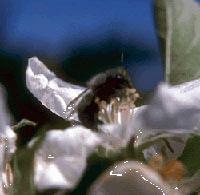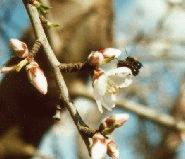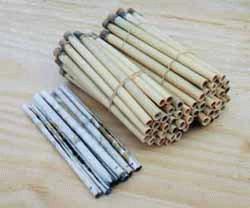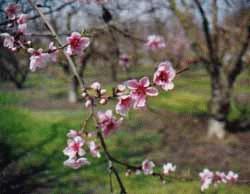Blue Orchard Bee Gallery
Blue Orchard Bee Publications
 The blue orchard bee (a.k.a. orchard mason bee, Osmia lignaria) is a solitary bee, native to North America.
The blue orchard bee (a.k.a. orchard mason bee, Osmia lignaria) is a solitary bee, native to North America.
This bee is about 3/8 to 5/8 inch (9 to 16 mm) in length and is a dark metallic blue. Males are smaller than females, and have a tuft of white hairs on their face and have longer antennae. Blue orchard bee females make their nests in pre-existing holes in wood. They do not tunnel into the wood to create holes.
 The optimal hole size for the orchard bee is 4 to 6 inches (10 to 15 cm) deep and 5/16 inches (7 mm) in diameter. The females make several cells in each hole, using mud to separate the cells. There can be from one to twelve cells in a nest hole, but on average there are 4 to 5 cells per nest. Females provision each cell with enough pollen and nectar to rear one larva. Female eggs are laid towards the bottom of the nest, while males are deposited towards the front of the hole. There are usually about 2 males for every female bee. When the egg hatches, the young larvae feed on the pollen until it is completely consumed. The larvae then spin a silken cocoon in which they pupate. After several days, the pupae molt one final time into the adult stage. The adult bees then enter a state of dormancy called diapause, until winter is over. In the spring, when temperatures begin to warm, the adults chew out of their cells and the females begin foraging to make new nests.
The optimal hole size for the orchard bee is 4 to 6 inches (10 to 15 cm) deep and 5/16 inches (7 mm) in diameter. The females make several cells in each hole, using mud to separate the cells. There can be from one to twelve cells in a nest hole, but on average there are 4 to 5 cells per nest. Females provision each cell with enough pollen and nectar to rear one larva. Female eggs are laid towards the bottom of the nest, while males are deposited towards the front of the hole. There are usually about 2 males for every female bee. When the egg hatches, the young larvae feed on the pollen until it is completely consumed. The larvae then spin a silken cocoon in which they pupate. After several days, the pupae molt one final time into the adult stage. The adult bees then enter a state of dormancy called diapause, until winter is over. In the spring, when temperatures begin to warm, the adults chew out of their cells and the females begin foraging to make new nests.
 Blue orchard bees will accept a variety of nesting materials such as drilled wood blocks, styrofoam, reeds or paper straws. The nests need to be protected from direct sunlight and rain. Nests should face south or southeast and dark colored nests are preferred over light colors. A source of mud, such as a stream or canal, should be available nearby. The completed nests should be stored in a dry shady place over the summer as the larvae develop. In the fall, when all the offspring have reached the adult stage, the nests should be refrigerated.
Blue orchard bees will accept a variety of nesting materials such as drilled wood blocks, styrofoam, reeds or paper straws. The nests need to be protected from direct sunlight and rain. Nests should face south or southeast and dark colored nests are preferred over light colors. A source of mud, such as a stream or canal, should be available nearby. The completed nests should be stored in a dry shady place over the summer as the larvae develop. In the fall, when all the offspring have reached the adult stage, the nests should be refrigerated.
 The nests can be held in refrigeration until the following spring when they are needed. Emergence of the adults will occur from 2 to 10 days after being warmed up. The blue orchard bee is an excellent pollinator of apples, pears, cherries, plums, peaches, nectarines, almonds, currants, blackberries, raspberries, and strawberries. Blue orchard bees are extremely efficient pollinators.Studies have shown that only 250 females per acre are needed to pollinate apples, while 300 females per acre are needed for almonds. The females do have a stinger, but rarely use it. They do not defend their nests against intruders, and these bees are quite safe to have around children or pets.
The nests can be held in refrigeration until the following spring when they are needed. Emergence of the adults will occur from 2 to 10 days after being warmed up. The blue orchard bee is an excellent pollinator of apples, pears, cherries, plums, peaches, nectarines, almonds, currants, blackberries, raspberries, and strawberries. Blue orchard bees are extremely efficient pollinators.Studies have shown that only 250 females per acre are needed to pollinate apples, while 300 females per acre are needed for almonds. The females do have a stinger, but rarely use it. They do not defend their nests against intruders, and these bees are quite safe to have around children or pets.
References
Griffin, B.L., 1993. The Orchard Mason Bee, Knox Cellars Publishing, Bellingham, WA 69 pp.
Torchio, P.F. 1987. Use of non-honeybee species as pollinators of crops. Proc. Entomol. Soc. Ontario 118: 111-124.
